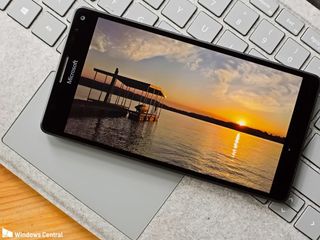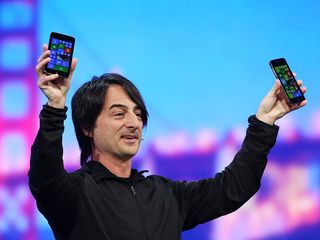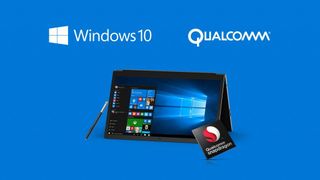Why Microsoft's 'we have Windows 10 Mobile for phones' doesn't contradict Pocket PC vision
Many Windows phone fans are anticipating Windows 10 on ARM with CShell on a pocketable device. But how does Microsoft's Corporate Vice President in the Operating Systems Group Joe Belfiore's statement, "we have Windows 10 Mobile for the phone experience", fit into this scenario?

In July, Belfiore stated:
The Windows 10 on ARM effort is about enabling the PC experience on devices that are built on ARM so that they're connected all the time and have great battery life. So the experience is a desktop PC experience, it's not a phone-like experience. For phone-like experiences on ARM, we have Windows 10 Mobile. What Windows 10 on ARM is, is a desktop-like experience so that you get the battery life that ARM processors tend to have.
Belfiore makes several points:
- Microsoft has Windows 10 Mobile for phone experiences.
- Window 10 on ARM is for desktop experiences.
- WOA is for always-connected PC experiences and great battery life.
Some people believe Belfiore's statements preclude the possibility of a modular version of Windows that will run on all form factors, including a pocketable telephony-enabled device. So how do we reconcile Belfiore's "we have Windows 10 Mobile for the phone experience", with the expectation of a modular form of Windows on a potential telephony-enabled pocket PC?
We have Windows 10 Mobile for that
Belfiore's statements regarding Windows 10 Mobile were referring to its present and immediate future, not the long-term.

We know that Windows 10 Mobile will remain supported as the phone experience until its imminent demise after 2018 when support for the mobile OS ends. Until that time it, not full Windows 10 on ARM, is what Microsoft has for the phone experience.
I believe Belfiore's statements, like those of many high-level executives, were carefully crafted. He technically spoke the truth about Windows 10 on ARM while retaining the secrecy of Microsoft's plans for Windows 10 Mobile.
Earlier this month, Zac Bowden's sources confirmed our ongoing analysis that Windows 10 Mobile will be replaced by a full version of Windows that will run on all form factors as Microsoft continues its Windows-on-mobile strategy.
Get the Windows Central Newsletter
All the latest news, reviews, and guides for Windows and Xbox diehards.
Even if Windows 10 Mobile succeeded Microsoft would have pursued a post smartphone strategy
Windows 10 on ARM is for ARM-based PC experiences
Belfiore stressed: "The Windows 10 on ARM effort is about enabling the PC experience on devices that are built on ARM so that they're connected all the time and have great battery life."

Belfiore's assertion in no way contradicts the analysis that Microsoft's vision for full Windows 10 on all form factors will include a Continuum- and telephony-enabled pocket PC running CShell. In fact, it reinforces Microsoft CEO Satya Nadella's assertion that Continuum-enabled mobile devices will be able to serve as a user's only PC.
To enable the full mobility of a device that will act as a full PC and have mobile capabilities, Windows 10 would need to run on ARM, have constant connectivity and great battery life. If we view Microsoft's strategy as bringing a PC to the mobile space and not that of forcing full Windows 10 on a phone (as some incorrectly assume I'm proposing) Belfiore's statements begin to fall into place.
Both Windows 10 on ARM and Continuum are about enabling the PC experience on ARM-based devices.
Yes, Microsoft's investments in Windows 10 on ARM have an immediate application in the form of the cellular PCs we will see this year. This phase in Microsoft's mobile strategy is about enabling the PC experience on ARM-based laptops, tablets, and 2-in-1s. The parallel here is that Microsoft's goal is also to enable the PC experience on Continuum-enabled pocketable ARM-based Windows devices.
When we take a holistic view of Microsoft's investments, we realize that its Continuum strategy — making a mobile device a full PC experience — and its Windows 10 on ARM strategy in bringing the full PC experience to ARM-based devices, are invariably connected.
The power of a PC with CShell and Continuum
If a Continuum-enabled mobile device is to replace a user's PC, that mobile device must be a full PC. Thus, we must recognize that Microsoft's strategy is likely that of optimizing a PC for the mobile space and adding mobile functionality. The distinction between this and cramming Windows 10 on a phone cannot be overstated.
Nadella's vision for Continuum as a means for a user to have a full PC experience necessitates that the mobile device in-hand has the power of a PC. Continuum is simply the medium to convey that PC power to a desktop context when connected to a monitor, mouse, and keyboard or Lap Dock-like device.
Why Windows 10 S, Project Centennial are critical to Continuum's success
CShell will ensure that the UI and OS conform to a user's context. Readers concerned about a desktop experience on small screen needn't be. The UI when not in Continuum mode would be mobile- and touch-friendly.
Yeah, I know, the app gap
None of this directly addresses the app gap problem. The strategy does benefit from Microsoft's investments in Windows 10 S as a means to modernize the PC experience, however. Windows 10 S runs only Store apps and potentially creates an incentive for developers to use Project Centennial to begin converting Win32 apps to UWP apps.
Windows 10 S breathes new life into UWP — and paves the way for 'Surface phone'
The modernization of Win32 apps would help populate the Windows Store and could potentially encourage other developers to begin developing UWP apps.

Full migration to UWP makes apps more secure and enables Windows 10 features like notifications, Cortana integration, live tiles and a XAML interface.
A growing ecosystem of UWP apps could encourage mobile app developers to develop for this ultramobile PC category with telephony and a mobile form factor and context-conforming UI.
Wrap up
Microsoft's strategy, I believe, is the unprecedented synergy or merger of a mobile and PC effort. It's an uphill battle that isn't targeting the iPhone or Android phones. It's about carving out a position for a new type of telephony-enabled PC with support from OEM partners. There are no guarantees but if that proves to be a solid, albeit initially small market, it may be stable enough for developers to target these ultramobile PCs with mobile-specific apps as well.
Belfiore's statements stress the importance of the PC experience which is core to Microsoft's Continuum-powered one device for all scenarios strategy. This Windows 10 with CShell ultramobile PC will, in my estimation, be an evolving category. Like most tech, it won't upon introduction be in power and capabilities what it is ultimately intended to be.
Belfiore's Windows 10 on ARM statements, UWP, what we know of Windows Mobile's imminent demise, CShell and Andromeda and the role of Continuum in Microsoft's mobile strategy are the foundation to this device category.
Joe Belfiore's statements, support rather than contradict this analysis.
Jason L Ward is a columnist at Windows Central. He provides unique big picture analysis of the complex world of Microsoft. Jason takes the small clues and gives you an insightful big picture perspective through storytelling that you won't find *anywhere* else. Seriously, this dude thinks outside the box. Follow him on Twitter at @JLTechWord. He's doing the "write" thing!

